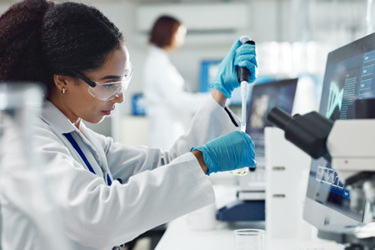How Sethera Harnesses A Promiscuous Enzyme To Make Recombinant Peptides
A conversation with Karsten Eastman, Ph.D., and Vahe Bandarian, Ph.D., Sethera Therapeutics

A peptide developer is exploring the edges of peptide engineering with a class of enzymes that enables post-translational modification on a variety of substrates. Their work challenges the conventional wisdom about specificity limits.
Sethera Therapeutics, a preclinical biotech in Salt Lake City, is using a “controllably promiscuous” enzyme, specifically, an rSAM (radical S-adenosyl-L-methionine) RiPP (ribosomally synthesized and post-translationally modified peptide maturase, to install thioether cross-links in peptides with a level of specificity and tolerance to a degree its leaders, CEO Karsten Eastman, Ph.D., and Chief Scientific Officer Vahe Bandarian, Ph.D., say hasn’t been done before.
The company is also addressing practical challenges such as reaction scalability, analytical verification, and batch-to-batch consistency. By combining solid-phase peptide synthesis (SPPS) with enzymatic editing, Sethera aims to streamline production while accessing chemical architectures that are difficult to achieve through synthetic chemistry alone.
As interest grows in chemoenzymatic approaches to drug development, we wanted to know more about the company’s approach, and Eastman and Bandarian agreed to help. Here’s what they told us. Answers have been edited for clarity.
What are “controllably promiscuous” enzymes, and where have they (and enzymes generally) fit in the recombinant peptide ecosystem?
Eastman: We use “controllably promiscuous” to describe enzymes with broad intrinsic substrate scope whose activity can still be directed by simple handles. In the context here, the RiPP (ribosomally synthesized and post-translationally modified peptide) leader sequence and a minimal set of chemical features in the core (e.g., a thiol + carboxylate) direct the modifications. We have shown that PapB is a great example: it tolerates wide variation in sequence length and composition between a thiol donor and a carboxylate acceptor. It consistently installs thioether cross-links at the intended motif (alpha or beta to the carboxylate). This combination, broad tolerance but predictable outcome, is what makes rSAM RiPP maturases “controllably promiscuous.” We have published several studies that map this tolerance systematically.
Historically, recombinant peptide ecosystems leaned on proteases (in the case of insulin to achieve its final active form) or on NRPS (non-ribosomal ribosomal peptide synthetase) systems. We have been able to demonstrate that rSAM RiPP enzymes broaden the available chemical space by enabling diverse editing of peptides. While the preliminary work only shows diverse thioether formation, there are additional rSAM RiPP maturases that install other bonds that are synthetically nontrivial (C–H functionalization, C–N/C–C/C–O bond formation).
From the active enzyme, we demonstrated generality on both native and non-natural peptides, including drug-like targets. We believe that is how rSAM RiPP enzymes will increasingly function in the future: as chemoenzymatic editors that slot into SPPS/recombinant pipelines to forge otherwise inaccessible macrocycles/bridges with precise regiochemistry.
Bandarian: We were studying what we thought was a very specific enzyme in the context of the reaction that it did. But then we discovered that it could do a lot more than we anticipated based on textbook chemistry.
That's where this whole thing started for us. We were trying to understand how an enzyme functions and then discovered all the promiscuity as a side note, which became the main project.
How are you engineering them to install modifications that natural enzymes couldn’t do before?
Eastman: We exploit innate promiscuity, then refine. Our first lever has been substrate‑side engineering rather than protein mutagenesis. PapB recognizes “leader plus a thiol and carboxylate” and will still cyclize D‑amino acid variants, expanded/contracted spacings, branched/elongated side chains (penicillamine and methyl aspartate or even homocysteine and homoglutamine), and even a tetrazole in place of the acceptor carboxylate.
We assemble test peptides by SPPS and then see if PapB can generate the bridge/macrocycle. This has enabled installation of disulfide‑mimetic (but reduction‑resistant) thioethers in non‑natural peptides and scanning of non‑proteinogenic residues to chart what will/won’t turn over.
We are expanding to look at enzyme-side engineering but we are still in the early days of exploration. We understand a great deal about the critical residues and catalytic cycle from our mechanistic work: SeCys‑substitution/XAS work demonstrated direct substrate contact at an auxiliary (4Fe‑4S) cluster in PapB/Tte1186, clarifying how the product‑forming step couples to the auxiliary cluster and helping us predict when altered donors/acceptors will (or won’t) engage productively; we understand that mutating away AC2 leads to only a single turnover; and we have done single residue mutants in the active site that abolish activity completely. With this understanding and some of the new computational tools that have been released, we are also working on generating active forms of enzymes that have better expression and solubility.
Bandarian: Everything we know about enzymes, we learned starting in the 1900s through glycolytic enzymes — the things that worked on sugars. The early ideas about enzymes were all built on things that worked on small molecules. If you look at enzyme active sites with small molecules bound, they tend to make very specific interactions and engulf the entire small molecule.
If you think about a 200- to 400-amino acid protein working on peptide of 20 to 50 amino acids, there is no way that the enzyme is going to engulf the entire peptide. The specificity for that sequence is going to be at the level where the chemistry takes place and nowhere else. So, you can do a lot of things with a peptide that normally you wouldn't be able to do with a small molecule.
We didn't expect this when we started because the textbook says enzymes are very specific for the substrate they work on. That's true if you're modifying glucose; it's not true if you're working on a large peptide. And that's what we stumbled upon.
I honestly did not expect the initial experiments that we did on the system to work, but we had the protein, we had the peptide, we just went ahead and did it, and they worked. That became the basis for the first paper we published a few years ago, and it has become the basis for this entire project and Sethera.
To achieve enzymatic macrocyclization/bridge formation at scale, how do you maintain efficiency? Mass‑transfer or kinetic limits?
Eastman: Kinetics, not diffusion limits, appear to control redox and cofactors. In small-scale kinetics with msPapA, PapB shows multi‑s⁻¹ turnover under both dithionite and biological reducing systems (FldA/FPR/NADPH), and dithionite appears to be about 3 times faster. Practically, scale-up is therefore about maintaining reductive activation and Fe–S integrity: anaerobic buffers, continuous low-O₂, and control of reductant to avoid over‑reduction or radical quenching.
Bandarian: It's all engineering. At the end of the day, if the enzyme can’t do what we're doing with it, why would we make more of it or optimize it?
We can make what we need for the level we’re working at. I'm confident, given time and resources, we'll be able to push that to wherever it needs to be, whether it's a quantity of peptide or quantity of enzyme.
Making recombinant proteins is not difficult. Those are all problems that you can work out once you know exactly what you need to purify specifically for that purpose, specifically for the scale. I'm a biochemist. We've been making pure protein forever. Every protein is a little bit different, but once you figure it out, you've got it, and we've got it with this one. I'm sure we can do it for other things as well.
For analytical challenges, are standard methods enough to prove modification?
Eastman: Mass spectrometry is necessary but not always sufficient. For β/γ‑thioethers, intact‑mass liquid chromatography (LC‑MS) shows the canonical –2 Da shift per cross‑link, and MS/MS shows no fragmentation within the macrocycle plus the diagnostic 2 Da patterns on b/y ions around the linkage; this is usually definitive for PapB‑type linkages and was our primary readout for broad substrate panels (including IAM tests to verify loss of free thiols). However, distinguishing Cα versus Cβ/γ thioethers (sactipeptides vs. ranthipeptides) or parsing mixed populations (e.g., partial dAdo‑adduct formation) can require careful fragmentation logic and orthogonal confirmation.
There are some specialized probes for mechanism and edge‑cases. To interrogate auxiliary‑cluster engagement and ambiguous cases, we augmented MS with element‑specific spectroscopy and site‑designed probes. Our selenocysteine substitutions enabled Se K‑edge XAS/EXAFS, directly revealing substrate — AC-Fe interactions in the Michaelis complex and clarifying redox‑coupled bond‑formation steps, evidence we can’t obtain from MS alone. For enzyme quality control, we also use UV–vis/ICP‑MS on the enzyme to quantify cluster load/state before catalysis. In short, standard LC‑MS(/MS) is the backbone for product ID, but cluster‑level spectroscopy (and sometimes NMR for large material campaigns) is invaluable for mechanism and troubleshooting.
Bandarian: It depends on what we're asking. The analytical method we're using, the mass spec, is extremely sensitive, which is why having the purified protein and purified peptide allows us to see things that you may not have if you did not work with those purified materials. Even with a small amount of turnover, we can see and then we can optimize to get to the real products.
I’ll add that in a typical assay, we tend to have excess substrate over enzyme. Here, we get complete conversion of the substrate to the final product. So those reactions are pretty well-optimized at this point.
To maintain batch‑to‑batch consistency when activity depends on an enzyme, what are the CPPs and how do you monitor them?
Eastman: We perform QC on the enzyme, then QC on a peptide panel. Every enzyme lot should pass
- Fe–S occupancy checks (UV‑vis features, ICP‑MS iron content consistent with ~3 [4Fe–4S] clusters/monomer; removal of reconstitution aggregates) and
- redox competence checks (initial rates under a standard reductant system). We then challenge the lot with a panel of peptides spanning “easy” and “hard” substrates: a canonical CX₃D (“easy”), edge‑case spacings, and representatives with unnatural residues, all prepared by SPPS.
The critical process parameters we track are: Fe–S cluster loading/reconstitution method, choice and delivery of reductant (dithionite vs FldA/FPR/NADPH or related), SAM quality and feed, anaerobiosis, and enzyme to substrate ratio. Two of these deserve special emphasis:
- Fe–S reconstitution is essential — lots with sub‑stoichiometric iron/sulfide or with unremoved aggregates are low‑performing; and
- reducing systems must be carefully tested, not assumed. PapB’s apparent k_cat differs measurably between dithionite and biological systems.
What’s the value proposition: new architectures or cost reduction vs. purely synthetic routes?
Eastman: Primarily, it’s access to new architectures and properties. The headline win is chemical space: rSAM maturases forge site‑specific C–S linkages at unactivated carbons with regiocontrol that is difficult to match synthetically. In peptides, disulfide → thioether replacement can deliver redox‑stable macrocycles with preserved topology. Because PapB tolerates D‑residues, spacings, branched/extended side chains, and even carboxylate isosteres, we can explore medicinally relevant variants quickly, something we enabled by combining large-scale maturase production with SPPS for fast substrate iteration.
Cost and operational benefits are real but secondary. Versus multistep synthetic cyclizations (protecting-group gymnastics, dilute macrocyclizations, late‑stage chemoselectivity issues), a single enzymatic step under mild conditions can reduce steps and rework, particularly for panels of analogues. But the decisive value we’ve seen is performance: formation of robust thioether macrocycles/bridges and other rSAM-type edits that chemistry alone either cannot do or does with far less selectivity. The field trend mirrors this: as labs standardize Fe–S reconstitution and fit-for-purpose reducing systems, rSAM RiPP enzymes are moving from curiosity to modular biocatalysts in the peptide engineering stack.
Bandarian: It's hard to put a cost on something you can't do. Right?
If it’s prohibitively expensive to do, then it's just not possible. So with these enzymes, we're able to at least get the screens going, and once we discover something, there are probably other ways of making the structures that maybe don't require the enzyme, but if you don't know what you're making, then you can't really ask the questions.
So the enzyme really enables the complex architectures, which are not possible any other way. Once you find something, then you engineer the most cost-effective way of getting there, whether it's with an enzyme or a chemical means, or a combination of the two of them with the chemo-enzymatic process. We're enabling that initial piece, which really isn't possible any other way.
About The Experts:
 Karsten Eastman, Ph.D., is CEO of Sethera Therapeutics. He received a Ph.D. from the University of Utah under the mentorship of Vahe Bandarian, where they discovered the key processes that enable Sethera Therapeutics’ technology.
Karsten Eastman, Ph.D., is CEO of Sethera Therapeutics. He received a Ph.D. from the University of Utah under the mentorship of Vahe Bandarian, where they discovered the key processes that enable Sethera Therapeutics’ technology.
 Vahe Bandarian, Ph.D., is president and chief scientific officer at Sethera Therapeutics. He is a distinguished faculty member and associate dean at the University of Utah and a fellow of the American Chemical Society, the American Association for the Advancement of Science, and the American Society for Biochemistry and Molecular Biology (ASBMB). His research has earned him a Pfizer Award in Enzyme Chemistry from the ACS and the Distinguished Research Award from the University of Utah.
Vahe Bandarian, Ph.D., is president and chief scientific officer at Sethera Therapeutics. He is a distinguished faculty member and associate dean at the University of Utah and a fellow of the American Chemical Society, the American Association for the Advancement of Science, and the American Society for Biochemistry and Molecular Biology (ASBMB). His research has earned him a Pfizer Award in Enzyme Chemistry from the ACS and the Distinguished Research Award from the University of Utah.
